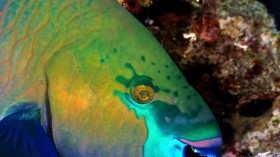Dubbed as the "Western Pacific Biotwan," scientists Oregon State University's Hatfield Marine Science Center have recorded a remarkable sound coming from Mariana Trench Marine National Monument the deepest known part of the Earth's oceans, found between Japan to the north and Australia to the south. Researchers believe the five-part call, which lasted for between 2.5 and 3.5 seconds, is from a baleen whale.
Describing the call, which involved deep moans at frequencies as low as 38 hertz and a metallic finale that pushes as high as 8,000 hertz, Sharon Nieukirk, senior faculty research assistant in marine bioacoustics at Oregon State, said, "It's very distinct, with all these crazy parts. The low-frequency moaning part is typical of baleen whales, and it's that kind of twangy sound that makes it really unique. We don't find many new baleen whale calls."
Nieukirk and her team picked up the sound using passive acoustic ocean gliders, which are instruments that can travel autonomously for months at a time and dive up to 1,000 meters. The Western Pacific Biotwang most closely resembles the so-called "Star Wars" sound produced by dwarf minke whales on the Great Barrier Reef off the northeast coast of Australia, researchers say, an article by Eureka Alert reports.
Minke whales feed using baleen plates in their mouths to sift out krill and small fish from seawater, hence the name baleen whale. These whales produce specific calls depending on the region. Aside from the Star Wars-like call, the sound also feature "boings" in the North Pacific and low-frequency pulse trains in the Atlantic.
"Now that we've published these data, we hope researchers can identify this call in past and future data, and ultimately we should be able to pin down the source of the sound," Nieukirk said.
"More data are needed, including genetic, acoustic and visual identification of the source, to confirm the species and gain insight into how this sound is being used," she added.
Nieukirk is hoping to conduct an expedition that will focus on finding the origin of the sound via acoustic localization, identifying the animals and getting biopsy samples.
"It really is an amazing, weird sound, and good science will explain it," she said. The results of this study is published in the Journal of the Acoustical Society of America.
© 2024 NatureWorldNews.com All rights reserved. Do not reproduce without permission.





